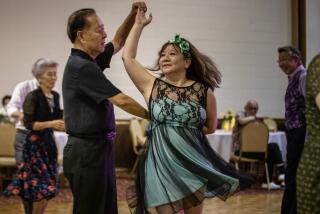One Step at a Time
- Share via
NORTH HOLLYWOOD — Rusty Frank would be the first to say that she is not necessarily a spiritual person.
Although sensitive and optimistic, the professional swing dancer likes to take charge and leave little to chance.
But Frank’s divine perspective changed June 2, when she landed on her head and broke her neck in five places while practicing a dance move with her partner, Peter Flahiff of Santa Ana.
The accident cracked her vertebrae, leaving her temporarily paralyzed from the neck down. After the swelling goes down in her neck, she’s expected to get all the feeling back in her limbs, doctors said.
As she recovers from her injuries, Frank said she has experienced an outpouring of kindness that has deepened her faith in humanity.
“From the moment I was picked up off the grass, I feel like I have been in this cradle of thought, love and compassion,” she said during an interview last week. “I have this sense that this cradle will not be put down on the ground until I am 100% walking and dancing again.”
After 15 days of intensive physical therapy at Northridge Hospital Medical Center, Frank returned home.
Although Frank will continue her therapy as an outpatient, she said her return home to her North Hollywood apartment was a major step in her recovery.
“It’s so good to be in my own home, to have my life back, to get away from being stuck, poked and prodded,” she said.
Frank, a professional swing and tap dancer for 16 years, normally divides her time between teaching and performing. She and Flahiff, who two years ago launched their act, Swing Shift, teach at USC, Manhattan Beach and Hermosa Beach and perform internationally.
She also produced, directed and appeared in the all-star tap revue, Jazz Tap!, featuring the Nicholas Brothers and Savion Glover. She is a contributing author to the Oxford Encyclopedia of Dance.
But her career, and life, took an unexpected turn on a sunny Friday afternoon outside her Riverside Drive apartment. She and Flahiff were practicing a move they have performed many times.
“‘I was up in his arms and I was supposed to dive down through his legs and end up behind him,” Frank said. “When I went to reach for his legs, I ended up crashing on my head. There was a lot of cracking, and my whole body went completely numb.”
As Frank lay motionless on the grass, Flahiff ran into her apartment to call an ambulance.
As she lay on the lawn, thoughts of life and death swirled in Frank’s mind. “I remember thinking, ‘This is it. This is the end of my life,’ ” she said. “Then something said, ‘Yes, begin to fight.’ ”
*
Paramedics gingerly lifted her into an ambulance and raced her to the hospital. She was stabilized in the emergency room and taken to the intensive-care unit. Three days later, she was moved to a room in the Acute Rehabilitation Department, where she began therapy.
Frank does not hold Flahiff responsible for the injury.
“The first thing she said to me when I was able to see her in the hospital was, ‘You understand that this was not your fault, right?’ ” Flahiff said. “Psychologically, that was the best thing she could have done for me at that moment.”
As word of the accident spread, family and friends kept a constant vigil at the hospital. About 400 e-mail messages papered Frank’s hospital room walls.
Lovelynn VanderHorst of Pasadena, who is teaching and performing for Frank while she recovers, remarks on her friend’s attitude.
“She is learning to receive,” VanderHorst said. “She didn’t realize how many people love and support her and want to be there for her.”
Although Frank’s condition improved enough for doctor’s to release her from the hospital, her survival depends on a special neck brace. A titanium halo was screwed into her skull to stabilize her head and neck. It rests on a padded shoulder harness that is strapped to her chest and worn beneath her clothing. The halo cannot be removed for three to six months, until her neck properly heals.
“I’m still freaked out by it--knowing that the screws are drilled into your skull to hold you together,” Frank said. “Any wrong move right now and I’m either a quad [quadriplegic] or dead.”
Frank said she constantly reminds herself to follow doctors’ orders to take it easy.
*
“Rusty has a strong spirit and worked very hard to get back to doing what she loves: swing dancing,” said Amy Scheatzle, a physical therapist.
Occupational therapist Michelle Harris said she admires Frank’s perseverance.
“Rusty made a lot of functional gains quickly,” she said. “She gave 100% when relearning grooming, dressing and bathing, not to mention recruiting everyone into swing dancing.”
Last week, Frank went to visit her swing dance students at her Manhattan Beach dance studio. “I needed them to see me moving and walking and smiling.”
However, she soon discovered she didn’t need to be strong for them as much as she needed their love and support.
“I have seen the core of people that is good,” she said. “To have believed this my whole life, to actually see it on the faces of people and to know that it is really true, proves what I have always felt about humanity: People are good.”
More to Read
Sign up for Essential California
The most important California stories and recommendations in your inbox every morning.
You may occasionally receive promotional content from the Los Angeles Times.













